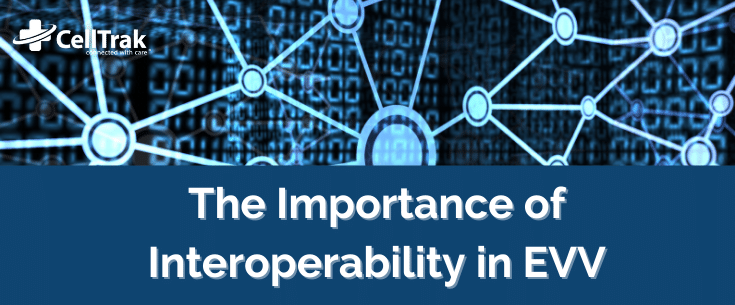How to Evaluate Free VS. Alternate EVV Solutions
EVV: The Importance of Interoperability
Electronic Visit Verification (EVV) compliance is on the minds of the majority of providers these days. Most agencies are moving quickly towards EVV implementation and are either evaluating or rolling out a solution.
In last month’s EVV blog, we discussed a few challenges providers face and recommendations for a smooth implementation. As you fine-tune your workflow and consider operational goals for your organization, technology choice will be front and center. At the top of the list of considerations should be interoperability- or in other words, how systems work together.
When interoperability matters
EVV requirements impact many processes and involve data from many systems across an agency such as Electronic Medical Records (EMR), billing, and payroll. As you evaluate an additional solution to capture visit information in the field, think about your entire workflow and consider how EVV will intersect with processes you already have in place. I would assert that if you consider interoperability up front, it will help you implement EVV with minimal disruption.
If you have just a few caregivers and a paper system today, maybe you can “check the box” with a simple, standalone solution. However, as you grow, complexity increases, and it will become difficult to manage your operation using primarily manual processes. With this complexity also comes increased opportunity - to streamline care delivery, unify a diverse care team to better support your patients, and better engage a large staff of caregivers.
Evaluating Free versus Alternate EVV? First, consider your workflow.
As you implement EVV, there are foundational processes you need to put in place to measure compliance, train staff, and reconcile claims. Over time, you will monitor progress and, potentially, evolve your approach.
So, how can you determine whether the free state-procured system will meet your needs? What alternatives should you consider as you decide on a technology solution? For starters, both options offer the same basics for check-the-box compliance, but the similarities end there. The primary defining feature is interoperability – and the most measurable metric is comparing the direct cost of purchasing an Alternate EVV solution to the indirect costs of implementing the free payor-procured option.
Here are three criteria to consider when choosing or adapting your approach to EVV compliance:
Assess the complexity of your compliance environment
Is your current operation delivering services in one state or multiple states? Do you bill to more than one payor? What percentage of your services are affected by the EVV mandate? If you will be required to meet the mandates of more than one state or payor, that can affect your technology decision. Make sure that you plan to use one solution for all visits. That solution should be easy for caregivers and configurable to meet the unique requirements of each payor.
Assess the needs of your operation
Another aspect of choosing an EVV solution is to align the solution with the needs of your operation and determine what can best complement your current workflow. We recommend assessing your agency-specific criteria to help narrow the choices. Does your EVV solution need to connect to existing EMR and payroll systems? How complex are your state’s requirements and what data is mandated? Do you need specific functionality such as delivering unscheduled visits or capturing task detail, for example?
Many agencies start there, then also consider what benefits they would like to realize with the new implementation. There can be cost benefits, such as decreasing time and mileage expenses, or productivity benefits, such as reducing administrative time to manually input or reconcile data. In addition, the right solution can help you retain staff with functionality such as better communication and safety features.
Consider direct and indirect costs
Last but not least, analyze the direct costs of purchasing an alternate EVV system against the indirect costs of implementing a free, state-procured system. Free payor systems procured by the state or an MCO do offer basic functionality but are typically not configurable to your specific operation and also not interoperable with your existing agency technology. Agencies facing complexity in EVV compliance often face a heavy lift to manage with the free system, a burden that typically outweighs the cost associated with purchasing an alternate system. So, map out your desired workflow and understand the impact of both choices. Finally, consider interoperability as a factor in bring data both back to your agency systems and forward to the state and MCO aggregators which require EVV visits.
How interoperability can simplify compliance for your agency
An EVV solution that is the right fit for your agency will help you standardize one mobile application, reduce manual work for administrators, and minimize disruption to your existing operation.
One of the industry’s leading providers, Addus, has been reliant on CellTrak for many years. They are moving forward with a single, integrated solution that includes best-in-class technology from CellTrak and Homecare Homebase to support their agency operations. They are continuing to evolve in their integrated approach because it helps them efficiently manage their business, and most importantly it helps them empower exceptional patient care.
So, think about compliance with a view forward. Consider your needs now, and also the growth you expect in the future. Free isn’t always free, so be prepared to take on some administrative challenges if you decide to start with a non-integrated solution. Interoperability is key – and although one output of EVV is certainly compliance, EVV offers so much more for your patients, your staff, and your agency.
Read the press release from Addus HomeCare and Homecare Homebase here

